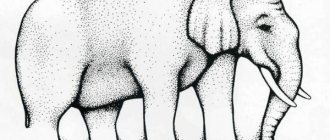The essence of cognitive processes and their types
Definition 1
Cognitive processes are a complex of mental functions that ensure the subject’s reflection and cognition of the phenomena of the objective world.
Note 1
The cognitive sphere of personality includes sensations, perceptions, imagination, attention, memory, thinking, and speech.
In cognition of the surrounding world, the primary psychological process is sensations, which are a reflection of the individual properties of objects that affect the human senses. The main part of each sense organ is the receptors, i.e. endings of the sensory nerve. Sensations are objective and subjective, if in the first case they always reflect an external stimulus, then in the second case they depend on the state of the nervous system and the individual characteristics of the person.
Are you an expert in this subject area? We invite you to become the author of the Directory Working Conditions
I. Sherrington identifies three main classes of sensations:
- exteroceptive, occurring when receptors are exposed to external stimuli,
- interoreceptive, forming organic feelings, for example, hunger,
- proprioceptive, with the help of which the brain receives information about the movement and position of body parts.
The minimum magnitude of the stimulus has a barely noticeable sensation and refers to its lower threshold. A person does not perceive signals whose intensity is less than the lower threshold. The maximum magnitude of the stimulus is the upper threshold of sensitivity.
If sensations reflect individual qualities and properties of objects, then perception reflects the object as a whole. Perception can be voluntary and involuntary. Voluntary perception is caused by the characteristics of environmental objects and their correspondence to the interests of the individual. Involuntary perception does not have a predetermined goal. Perception is characterized by such properties as integrity, constancy, structure, meaningfulness, and selectivity.
Finished works on a similar topic
Coursework The cognitive sphere of man 450 ₽ Essay The cognitive sphere of man 230 ₽ Test work The cognitive sphere of man 250 ₽
Receive completed work or specialist advice on your educational project Find out the cost
As for thinking, it allows you to reveal what is inaccessible to perception. This psychological process is associated with the discovery of new knowledge, with the creative transformation of reality.
Thinking can be visual-effective, visual-figurative, verbal-logical. The condition for thinking is a problem situation, and its main mechanism is analysis through synthesis.
Thinking includes imagination - the ability to imagine a non-existent object, hold it in consciousness and mentally manipulate it.
Development and learning are based on an important cognitive function - memory, which can be involuntary and voluntary.
From a genetic point of view, motor memory is considered primary - this is the ability to remember and reproduce a system of movements.
Different people have different types of memory - visual, auditory, motor, which differ in the level of their organization.
A person with a visual-figurative type of memory better remembers visual images, sounds, faces, and the color of objects.
The verbal-logical type of memory makes it possible to better remember verbal and often abstract material, formulas, and concepts.
The emotional type of memory preserves and reproduces the feelings experienced by a person.
Note 2
There is also a phenomenal memory, characterized by strong imagery - a person with such memory down to the smallest detail can “see” an absent object.
Spheres of personality
As a person involved in self-development, you have probably thought about improving some skills. But there are so many of them that sometimes you don’t know what to take on. What is more important: willpower or determination? This and similar questions can be confusing. However, if you know about the concept of the personality sphere, it becomes much easier to understand. For example, knowing that willpower and determination belong to the same group of abilities, you can draw certain conclusions.
In the online program “Self-Knowledge” you can better know yourself and your individual characteristics. With the help of psychological tests and exercises, you will find out what you really want in life and understand your strengths and weaknesses.
Personality spheres are a set of human characteristics that characterize his actions, motivations, ways to achieve goals, perception of information, needs, etc. Such categorization is needed not only for those who are engaged in self-development, but also, for example, for companies that are looking for employees.
The following areas of human personality are distinguished:
- motivational;
- strong-willed;
- organic and social;
- educational.
In this article we will look at these areas of human personality and try to understand how they are formed and what they depend on.
Motivational sphere of personality
Each person has his own specific needs, which prompt him to engage in one or another behavior aimed at satisfying these needs.
The level and quantity of needs differ from person to person: this is due to living conditions, different lifestyles, level of organization and place in society.
If basic needs (food, drink, warmth) do not change much during life, except perhaps their quantity, then others (self-realization, search for the meaning of existence) evolve along with a person. Much depends on moral values.
If we talk about the structure of the motivational sphere of the individual, then despite some differences, certain trends can still be identified. Here is an approximate diagram:
- Organic (food and drink requirements).
- Material (need for property and money).
- Social (need for authority, respect, sense of justice, self-esteem).
- Spiritual (faith, increasing spiritual level).
Psychologists pay the main attention to the motivational sphere of the individual, because human behavior aimed at achieving goals depends on motivation. We have done many things in our lives solely because we wanted to.
Main characteristics of the motivational sphere of the individual:
- Motivational Power: If a person is motivated enough, he is capable of doing a lot.
- Dynamics of motives: changes in the strength and priority of motives.
- The sustainable nature of motives: they do not disappear after satisfying certain needs.
- Availability of structure: several needs can be combined into one motivation.
- The existence of a certain hierarchy: there are secondary and dominant motives.
- Flexible nature: Each person can meet their needs in different ways.
- Multiple in nature: an increase in the needs themselves, means and ways to satisfy such needs.
- Diversity of motives: a large number of incentives to action.
It should be remembered that the motivational sphere of the individual is only one of several. You cannot judge a person by it alone. Let's look at others.
Volitional sphere of personality
The volitional sphere of personality is a set of volitional qualities that characterizes a person in his ability to achieve goals in difficult conditions.
The three most important qualities in this area: determination, willpower, willpower.
Determination is the ability in any situation to remember the plans and be focused on it until the bitter end.
By learning the basics of time management, we understand the importance of goal setting. But because of the irritants, we lose focus and begin to do completely different things, while experiencing shame and trying to get rid of cognitive dissonance with the help of excuses and looking for justifications.
To cultivate determination, you must first use tricks that are not directly related to it: even simple stickers posted throughout the apartment will have a significant effect. But at the same time you need to develop willpower.
Willpower is a person’s ability to make difficult decisions, as well as direct their actions and thoughts in accordance with the decision made.
It is an incredibly important component in achieving success. Even if a person has a highly developed motivational sphere, gaps in the volitional sphere will drag him down with every failure.
Willpower is necessary both to perform an action and to refuse it (which is no less important). For example, giving up cake for a future in sports or giving up a party with friends to learn English. Nowadays there are the greatest number of temptations in the entire history of mankind, so having willpower is one of the most serious advantages.
It is now fashionable to think that willpower is overrated, but it is rather underrated (all outstanding personalities possessed it). And if you can combine it with motivation, you will achieve the most ambitious goals.
Grit is the level of consistency and repetition of effort a person puts into achieving a challenging goal over a long period of time. Simply put, it is a scale for measuring willpower.
Yes, willpower is a finite resource, but it can be increased. This is willpower: how many minutes or hours can you work on a task without getting any results?
The volitional sphere of personality is also manifested in other aspects of human life. For example, in risk propensity and locus of control.
Risk appetite is a characteristic of human behavior in uncertain situations. It is believed that developed willpower makes an individual more risk-taking.
Locus of control is a person's tendency to attribute his failures or successes to either internal or external factors. An individual with a developed volitional sphere will take full responsibility for failures and failures (without suffering from self-flagellation and guilt).
Such a person knows that only he is responsible for his life and even other people’s reactions to him. While a person with an external locus of control (blaming circumstances) develops a victim syndrome.
Organic and social sphere of personality
A person cannot be considered outside the context of society. In addition to the volitional and motivational sphere of personality, the organic and social spheres develop simultaneously (it was studied by the Russian psychiatrist and neuropathologist Vladimir Bekhterev).
The organic sphere manifests itself in reactions to stimuli from the surrounding world, while the social sphere has a connection with the establishment of mutual understanding with members of the society in which a person is located.
As Bekhterev emphasizes, “the complex process of development of the social sphere of the individual does not in any way eliminate the organic sphere of the individual, it only complements it, although it partially suppresses it, so to speak, layers on it new combinations arising from actions related to the conditions of social life.”
Bekhterev placed character at the very top of the social sphere of personality. And only then comes concentration and mental performance. At the same time, he emphasized that these parameters are greatly influenced by temperament.
He also argued that the personality is characterized by volitional manifestations, internal motives for actions and deeds, that is, those mental phenomena that in psychology and philosophy are associated with will.
Cognitive sphere of personality
The cognitive sphere of personality is a set of abilities with the help of which a person cognizes the phenomena of the world around him. There is an opinion that the totality of all these elements is called intelligence.
This sphere consists of the following components: perception, sensations, attention, imagination, memory, thinking.
Sensations are what our receptors perceive from the external or internal environment.
Perception is how we interpret signals received through the senses. That is, this phenomenon can be called psychological, because he can change his perception with the help of volitional effort and a change in thinking.
Attention helps us focus on one stimulus, choosing it from everything that is around.
Memory is very dependent on attention, because what is remembered best is what a person was focused on. At the same time, memory is closely connected with all other elements of the human cognitive sphere.
Imagination is a person’s ability to conjure up images in the mind. It is believed that this skill is unique to humans; it helps plan the achievement of complex goals.
Thinking is a person’s ability to analyze received information. Sensation, perception, attention, memory and imagination are food for the mind, which is then processed by thinking.
All cognitive spheres of a person’s personality and their elements are amenable to training. On our website you will find courses and articles that will help you develop them, becoming a more versatile person. We advise you to start with the following courses:
- Cognitive Science;
- Leadership;
- Logical thinking;
- Making decisions;
- Self-knowledge.
We wish you good luck!
Did you like the article? Join our communities on social networks or our Telegram channel and don’t miss the release of new useful materials: TelegramVKontakteFacebook
We also recommend reading:
- Storytelling
- Using Maslow's pyramid for self-actualization
- Cognitive sphere of personality
- The need-information theory of P. V. Simonov
- 6 Skills to Develop Emotional Intelligence
- Achievement motivation
- Conditions for character formation
- Gordon Allport's Principle of Functional Personal Autonomy
- Self-actualization
- Humanistic theories of personality: what to take from history to modern times
- Psychosophy
Key words:1Self-knowledge
Memorization techniques
There are techniques designed to facilitate memorization and allow information to be recorded in the brain, converted into combinations of visual images - these are mnemonics.
A fairly effective way to remember information is rhyme and rhythm. This method, which is used in a number of mnemonic exercises, is widely used in advertising. Rhymed information is remembered much faster, is embedded in the memory regardless of desire, and it is often impossible to get rid of it.
Another memorization technique is an abbreviation (acronym). An abbreviation such as IMF, UN, etc. not only shortens long names of organizations, but also helps to remember them.
The method of remembering objects by recording their location came from Greece. A person uses this method quite often, although he is not aware of it. For example, it is difficult to immediately answer the question of how many windows there are in the house where a person lives, but if you imagine that he is walking through his house, then you can count all the windows.
The method of connecting numbers and letters is widely used to memorize numbers. The method helps to translate numbers into words because words have more meaning for a person. The correspondence between numbers and consonants is the basis of this method.
The picture method - the essence is to translate proper names into pictures based on their semantic meaning or sound. This method is especially useful for remembering people's professions and surnames.
To record proper names or just objects in memory, it is quite useful to use chains. To memorize, you need to connect each item from the list with the next one using associations.
Psychology of cognitive processes
The human psyche is a complex structure that ensures the receipt and processing of new information; it allows us to guide human behavior, make correct (as well as erroneous) decisions and creates our inner world. Cognitive processes connect the human person with the real world and allow him to interact with it.
We can say that the entire content of the human psyche is the result of his cognitive activity. The psyche is a reflection of the surrounding world, namely those of its elements with which this person interacted.
To understand the importance of cognitive processes for humans, we should remember which part of the brain is responsible for them. This is primarily the gray matter, which provides higher nervous activity. This structure is a distinctive part of the vertebrate brain, and the proportion of gray matter has steadily increased as evolution has progressed. In lower vertebrates (fish, amphibians), gray matter occupies a small part of the brain and acts as a kind of superstructure that contributes to better survival of the animal. But in higher primates, including humans, the gray matter is the main part of the brain, compared to which the more “ancient” parts are small in size. These highest representatives of the animal world are also distinguished by an extremely high level of mental cognitive processes. Cognizing reality and managing it from a “pleasant bonus” has turned into a vital necessity and the main type of mental activity.
Violation of cognitive processes really makes a person, to one degree or another, inferior and dependent. Mild impairments do not allow a person to take a worthy place in society, get a good job and achieve an acceptable standard of living. And more serious violations can even threaten physical health and life.
Cognitive processes in the system of mental phenomena
Perception is the simplest mental process, which consists in reflecting certain properties of objects and phenomena of the material world, as well as the internal states of the body under the direct influence of stimuli on the corresponding receptors.
Not all existing types of energy, even if they are vital, are perceived by humans in the form of sensations. For some of them, for example, the radiation is not felt mentally at all. Thus, a person receives in the form of sensations a small but very significant part of the information and energy acting on his body.
Lack of sensation leads to serious disruptions in the functioning of the body.
The following types of sensations are distinguished:
1) Upon contact with a stimulus:
- Far.
- Contact
- auditory
- visual
- olfactory
- tactile
- tastes
2) depending on the location of the receiver:
(a) interoceptive - signal about the internal state of the body.
b) Proprioceptive - signals the position of body parts and their movement.
c) Exteroceptive - signal various features of the external world (visual, auditory, skin, olfactory).
For sensations to occur, stimulation must reach a certain strength. For example, if we put a sugar crystal in a glass of water, we are unlikely to taste the sweetness. If we add one sugar crystal after another, we will eventually find that the water has become sweet. The minimum size of the stimulus that causes a subtle sensation is called the lower threshold of sensitivity. The lower the threshold, the higher the sensitivity. These thresholds are individual for each person. For example, one person hears very faint sounds (the ticking of a wristwatch), or one person perceives a dim, dim light, while for another the light needs to be a little brighter. In addition, different analyzers have different threshold values. For example, people have a very high sensitivity to smells. Visual and gustatory sensitivity are high, while tactile (skin) sensitivity is relatively low. Subliminal stimuli are called subliminal. The body does not perceive these irritants. This is definitely a protective reaction of the body, because if the body were to constantly receive and process information at all receptors, it would lead to exhaustion. The upper sensitivity threshold is the highest value at which sufficient sensitivity is still maintained [Error: Reference source not found,129]. For example, if we pour salt into water, we end up perceiving a bitter taste rather than a salty taste. In most cases, suprathreshold stimuli cause pain (eg, extremely loud sound, blinding brightness).
Absolute sensitivity is not constant throughout life: children's sensitivity develops and reaches its highest level during adolescence. It decreases with age. The activities a person engages in have a significant impact on sensitivity. For example, tasters are better at distinguishing flavors (experienced wine tasters can tell not only what grapes a wine is made from, but also where it was grown).
Sensations have the following characteristics:
Adaptation is the adaptation of the senses to external influences. For example, when we step out of a dark room into a bright light, we are momentarily blinded, but after a few minutes our eyes adapt and we see normally.
Synesthesia is the occurrence, under the influence of stimulation of one analyzer, of sensations characteristic of another analyzer. For example, a person experiences visual images under the influence of sound stimuli - visual-auditory synesthesia.
Sensitization is an increase in sensitivity as a result of interaction with the analyzer and practice. For example, weak musical tones can increase the sensitivity of the visual analyzer.
Structure and functions
Cognitive processes in psychology are considered the “youngest”. Even the centers of these processes are located in the neocortex - the youngest part of the cerebral cortex, with the exception of the centers of attention and memory.
However, these processes are at the same time extremely important for humans, since they perform a number of necessary functions:
- Reception of new information and its differentiation, for which there are different channels of information (visual, auditory, olfactory, etc.).
- Processing primary information and creating holistic subjective images.
- Data storage.
- Establishing connections between different types of sensory information, concepts, images, as well as connections between new information and existing information.
- Creation of concepts and signs, establishment of patterns between phenomena and processes of the surrounding world; signs are also used for communication, which is the basis of speech.
- Creating a strategy of behavior and its motives.
- Formation of goals and long-term objectives of activity.
- The ability to foresee the results of actions and plan one’s behavior.
A person's level of intelligence is determined by how effectively his cognitive processes perform their functions. Understanding the world around us, of course, does not happen spontaneously and chaotically.
It has a certain structure and consists of several stages:
- First, the brain receives new information and processes the received data.
- Then he uses methods of analysis, synthesis, comparison and generalization.
- The information received is remembered and saved.
- From the information received, new information is created - in the form of images and concepts.
- Finally, at the highest level of cognition, complex operations with data, including those of a predictive nature, are carried out.
Attention and memory
The process of cognition can be represented as a ladder, the ascent along which begins with sensations, then moves on to perception, thinking, imagination and ends at the top, which is creativity. But two cognitive processes stand apart. This is attention and memory. They play an auxiliary role and exist only in connection with other cognitive processes. But on the other hand, no intelligent human activity is possible without them.
Attention
This is the concentration of consciousness on external objects and phenomena or on internal processes. In order to perceive something, we must focus on it, and objects that do not fall into the sphere of attention are simply not noticed by us, that is, they are not included in the process of cognition.
There are two main types of attention: voluntary and involuntary.
- Involuntary attention occurs on its own, under the influence of specific stimuli. Such concentration, regardless of our desire, is caused by some strong, bright, unusual objects and phenomena, or those that matter to us and are associated with our interests and needs.
- Voluntary attention is a conscious activity aimed at maintaining concentration on objects that do not arouse interest. The significance of these objects is determined by the goals and objectives of the activity, and not by their brightness and unusualness. For example, to concentrate on a complex textbook text, you need to make an effort. Voluntary attention is often difficult, so it is necessary to develop conscious concentration skills.
In psychology, attention is considered both as a dynamic side of cognition and as its guide. It is this process that determines the selectivity of our consciousness, not only in terms of cognition, but also in mental activity in general. Attention is also associated with increased activity in various centers of the brain and makes any of our activities, including cognitive ones, effective and productive. And the loss of the ability to concentrate and concentrate, the involuntary loss of attention is a serious mental illness.
Types of cognitive mental processes
Cognitive processes did not arise all at once, and different animals are adapted to cognitive activity to varying degrees. Cognitive processes in psychology are divided into lower and higher.
The first group includes sensory-perceptual functions, namely sensations, perceptions and ideas. These processes are available not only to humans, but also to animals; however, if in animals they are the maximum degree of knowledge, then in humans they are only the initial degree. At the same time, these oldest functions of cognition are the most reliable and effective, since they ensure the flow of any information.
The second group includes thinking, imagination, speech and creativity. These are precisely those functions of cognitive activity that are characteristic only of humans. They are organized and managed consciously. Lower cognitive functions make their owner a passive observer of events in the surrounding world, and higher functions allow them to actively participate in these events, change the world and create new ones.
Among the processes of cognition, there are two more, also very ancient in origin and characteristic of even fairly primitive creatures. This is attention and memory. They play a supporting role and serve all other cognitive functions.











